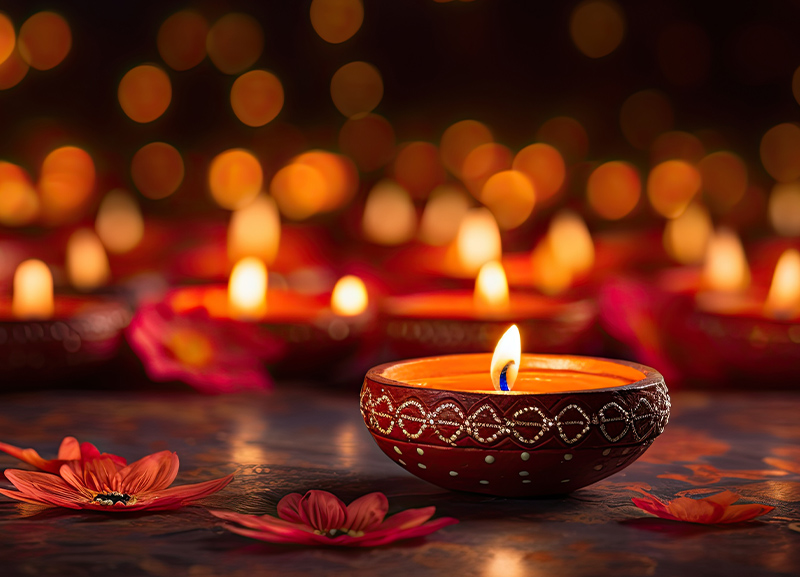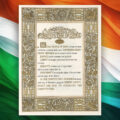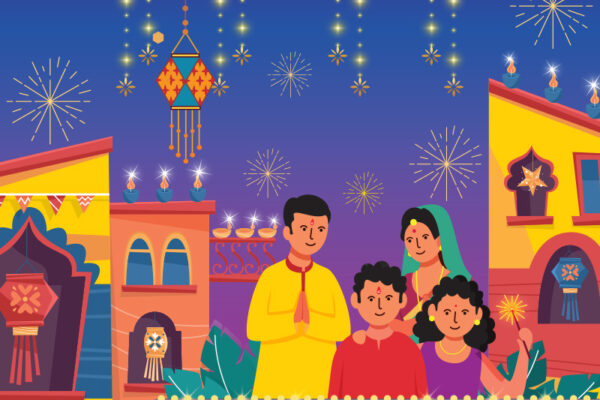
A for
Aarti
Hindu rituals and ceremonies are incomplete without an aarti. An aarti is an offering of light from a diya, flowers, incense, camphor and sweets. An aarti is often accompanied by chants or hymns. It is done with total dedication and admiration and profound love towards the deity.
Annakoot Puja
Annakoot Puja, also known as Govardhan Puja, is conducted on the fourth day of Diwali. This celebration marks the victory of Lord Krishna over Lord Indra. According to legends, the people of Gokul worshipped Indra, the god of rain. But Krishna convinced people to worship the Govardhan mountain or Annakoot hill instead, as the mountain provided them with food and was responsible for the rains. This made Indra very angry and he showed his anger by sending down unending thunderstorms. In order to rescue the people of Gokul, Krishna offered prayers to Govardhan and lifted it on the little finger of his right hand so that people could take shelter under it. For seven days, all the people and animals of Gokul remained safe under the mountain. Looking at Krishna’s powers, Indra realised he was no ordinary person. He stopped the rain and asked for forgiveness. Krishna put the mountain back in its original position and taught Indra the importance of dharma and duties.
The word ‘annakoot’ literally means ‘mountain of food’. People who celebrate this day stay up all night to cook 56 or 108 different types of food for the bhog, which is offered to Krishna. On this day, people also make hillocks and adorn them with flowers to represent the worship of Govardhan mountain.
Ayurveda
The first day of Diwali is celebrated as Dhanteras. Many legends associate this day with the Samudra Manthan, the day when the oceans were churned to find a pot of amrut (elixir of life). It is believed that when the gods and demons churned the ocean, one of the deities who came out was God Dhanvantari, the founder of Ayurveda, who emerged from the ocean carrying the pot of amrut.
On this day, people are offered a prasad of neem leaves and sugar. According to Ayurveda, neem is known for its anti-fungal and anti-bacterial properties and helps to keep harmful bacteria and fungi at bay. National Ayurveda Jayanti is celebrated annually on this day.
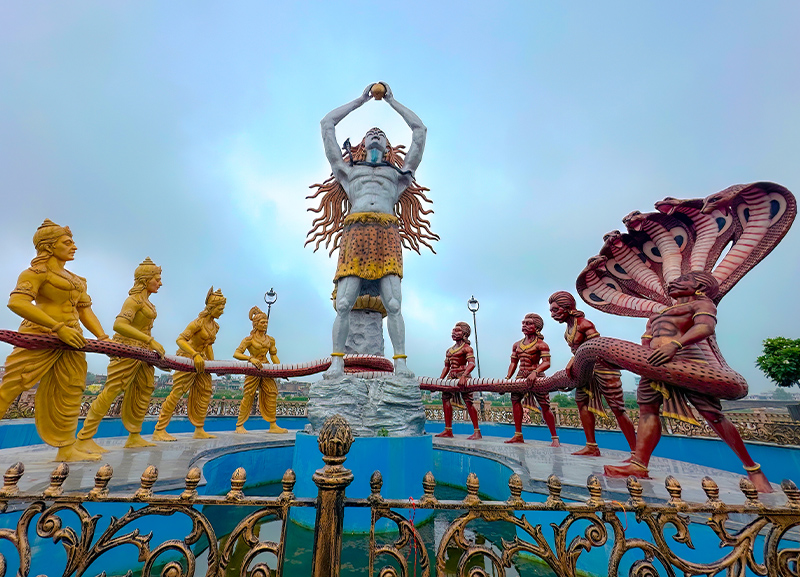
B for
Bagh Baras
In Gujarat, the day before Dhanteras is celebrated as
Bagh Baras. It is believed that the word ‘bagh’ means ‘to get
rid of one’s debt’. The business community in Gujarat often closes the year’s account books on this day and prays to Goddess Lakshmi to keep them completely free of debt in the next year. On this day, special food made with moong or green gram is served to cows and also eaten by family members.
Blessings
Diwali represents peace, victory and prosperity and people seek the blessings of pandits, parents and elders after the Lakshmi Puja. According to Hindu scriptures, parents and elders are next in line to god. Thus, people seek their blessings for the new year to ensure a prosperous year ahead.
Budhi Diwali
In Himachal Pradesh, especially in the districts of Kullu, Sirmaur and Shimla, Diwali is celebrated a month after it is celebrated in the rest of the country and is thus known as Budhi Diwali, which means ‘old Diwali’. Legend says that as Lord Ram returned after having killed Ravan, the news of his victory spread across the kingdom. However, it took almost a month for the news to reach the mountainous northern regions. The celebrations thus take place a month after Diwali. The celebrations are also associated with the killing of two demons, Dano and Asura, who lived disguised as snakes. Animal sacrifice is an important ritual at this time.
Bhai Dooj
Bhai Dooj is celebrated two days after Diwali day. On this day, sisters pray for their brothers’ safety and well-being. In return, brothers give gifts as a token of their love. This day celebrates the bond between brothers and sisters. In Bengal, this day is called Bhai Phota while in Maharashtra, it is known as Bhau Beej.
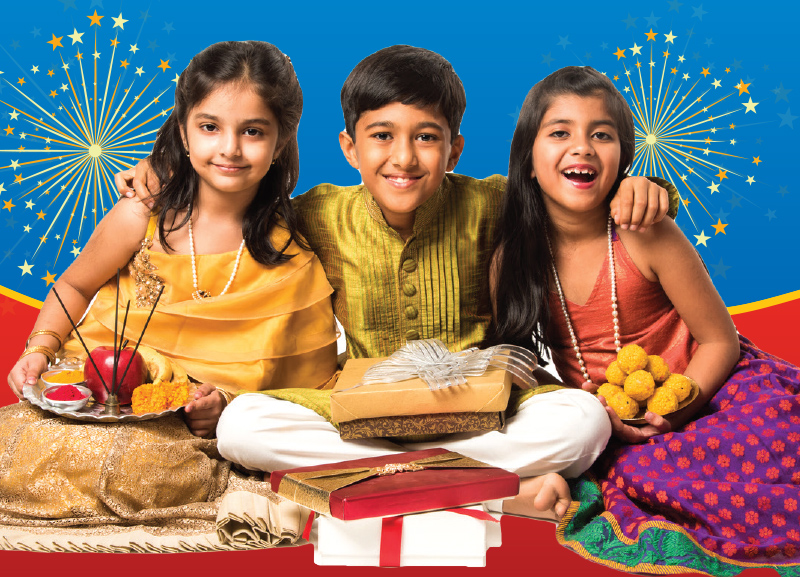
C for
Cows and Cattle
On Diwali day, farmers in rural India adorn their cows and cattle with jewellery and worship them. Cows and buffaloes are a major source of income for farmers as they not only help them on the farms, but also provide milk. In South India, cows are offered special veneration as they are supposed to be the incarnation of Goddess Lakshmi.
Chhath Puja
Chhath Puja takes place on the sixth day of the Hindu month of Kartik, in which Diwali is celebrated. Chhath Puja is an ancient Vedic festival dedicated to the Sun God or Surya Dev, who sustains life on Earth. Early morning sunlight helps cure many diseases and is a great source of healing. The sun’s radiation also cures fungal and bacterial infections. This festival is celebrated in northern and central India. During Chhath Puja, devotees observe a 36-hour-long fast to completely detoxify their mind, body and soul.
Cleaning
Cleaning is a big part of Diwali celebrations. Certain communities even worship the broom on Diwali day by offering it haldi (turmeric) and kumkum (vermilion) as it is a tool to clean the house and remove Alakshmi—Goddess Lakshmi’s sister who brings poverty, jealousy and fights into the house. It is also believed that Lakshmi will only enter and stay in a clean and well-kept house.
Most homes start their cleaning process a week before Diwali, where storerooms, cupboards, the kitchen and even the fridge is cleared of things that are not used. The things that are still usable are donated. Thus, charity also forms a big part of Diwali celebrations.
Chirate
Chirate is a bitter fruit from the cucumber family that is smashed under the heel on Narak Chaturdashi day. Crushing the fruit represents the killing of Narakasur by Lord Krishna. After the ritualistic early morning bath with uptan, called abhyanga snan,
a diya is lit and the fruit is broken under the heel to get rid of sins.
In some sects, a seed from the fruit is put on the forehead too.
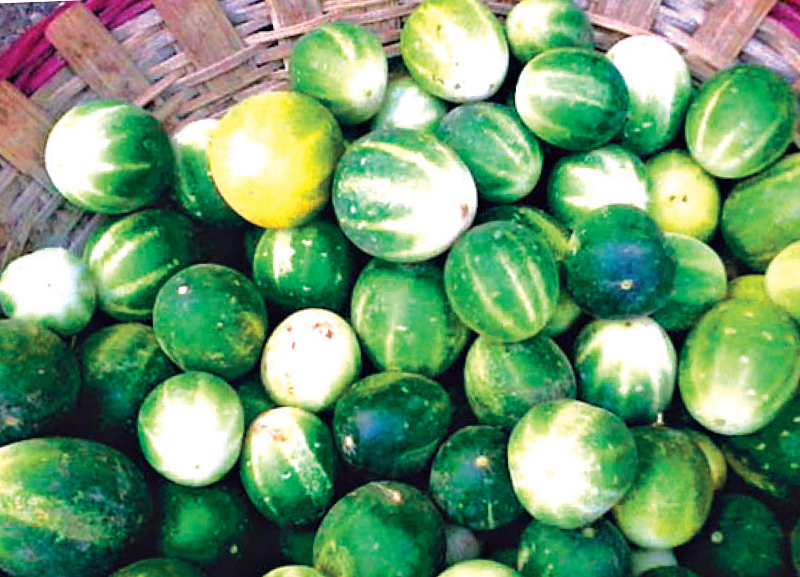
D for
Dev Diwali
Dev Diwali is celebrated on Kartik Purnima or the 15th day in the month of Kartik. Dev Diwali is celebrated to honour the victory of Lord Shiva over three demons—Vidyunmali, Tarakaksha and Viryavana. Shiva destroyed the three cities built by the demons. Hence, Dev Diwali is also known as Tripurotsav. It is believed that on this day, gods descend from heaven to Shiva’s town Kashi on the banks of the Ganga River to celebrate the festival. One of the most beautiful pujas takes place by the Ganga River on this day.
Dhanatrayodashi
The first day of Diwali is also known as Dhanatrayodashi. On this day, people in Maharashtra and some other states conduct a puja called Yamadeepdaan wherein mothers and wives make one flour diya each for all the male members of their family. These are lit and offered to Lord Yama, the god of death, in the evening to pray for the long life of the male members of the family.
Diyas
Diwali is synonymous with diyas. In fact, Deepavali literally means ‘rows of lights’. On the five days of Diwali, lit diyas are placed across the entrances of homes. This is symbolic and teaches an important lesson in unity because when placed together, the diyas give out more light. The flame always points upwards, which shows that our mind should be focused on the atman (soul or the higher self). Since the lights are always displayed by the walls of houses, in the streets and lanes, it shows that the inner spiritual light must be reflected outside for the benefit of society. To date, traditional homes will use mud diyas created by potters; this ensures that even the potter has enough money to look after his family during Diwali.
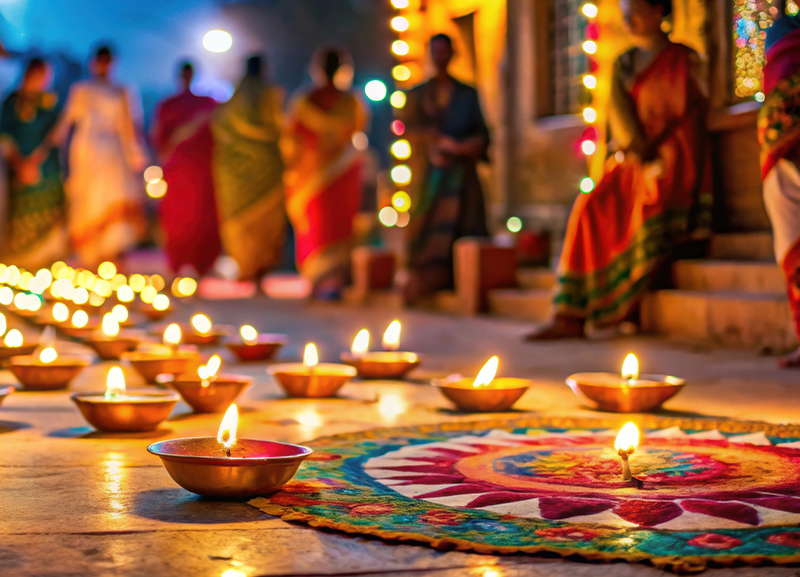
E for
Exile of Ram
Diwali was first celebrated to mark Lord Ram’s return to Ayodhya along with his brother Lakshman and wife Sita after 14 years of exile. Ghee lamps were lit and beautiful rangolis were made on the path Ram took. The festival is celebrated to commemorate their homecoming.
Emergence of Lakshmi
Another interesting legend related to Diwali says that Lord Indra, the king of gods, was deprived of the blessings of Goddess Lakshmi due to a curse by Rishi Durvasa. As a result, Indra lost all his wealth and valour. On the advice of Lord Vishnu, he performed the Samudra Manthan and Lakshmi emerged amidst the milky sea tides. It is believed that on the auspicious day of Diwali, Lakshmi visits the houses of her devotees and blesses them.

F for
Firecrackers
Diwali is incomplete without firecrackers. Scientifically, it is believed that the fumes produced by traditional firecrackers during this festival kill or repel insects, which are plentiful after the rains. The sounds of firecrackers also indicate the joy of people living on Earth, making the gods aware of their plentiful state. Firecrackers are thus an expression of respect for the attainment of health, wealth, knowledge, peace and prosperity.
However, one must also remember that firecrackers cause pollution; and many young children work in factories that manufacture firecrackers. So think twice before lighting up.
Footprints of Lakshmi
On Diwali day, Shripada or Goddess Lakshmi’s footprints are drawn from the entrance of the house right up to the temple or place of worship inside the home. These footprints are generally drawn using white rice or rice flour paste and vermillion. Symbolically, the drawing of Shripada indicates that Lakshmi has entered the house of her devotees.
Forts
In many rural areas in Maharashtra, children build forts outside their home on Diwali day. This tradition was started to create awareness about Chhatrapati Shivaji and his warrior attitude. However, forts also have a spiritual significance. Religious texts compare the human body to a fort, where flying the flag on top of the fort symbolises knowing one’s true self and having a balanced viewpoint. To defeat an enemy and take over a fort symbolises getting rid of dependence. Burning of oil lamps around the fort symbolises the importance of throwing light over darkness.
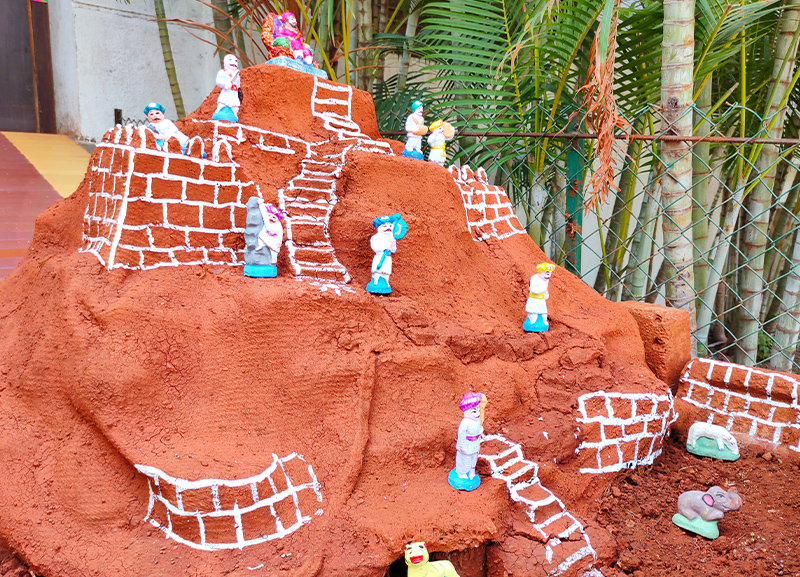
G for
Ganesh
On Diwali day, people worship Goddess Lakshmi with Lord Ganesh as they believe that wealth can only come with intelligence. Ganesh is also worshipped because he is the remover of all obstacles. A few myths explain why Lakshmi and Ganesh are always together.
It is believed that once Lakshmi grew very arrogant about her wealth and powers. While having a conversation with Lord Vishnu, her husband, she kept praising herself, claiming that she is the only one worthy of worship as she bestows money and wealth. Vishnu thus decided to get rid of her arrogance. He said that no matter what her qualities, a woman remains incomplete if she does not bear children. At that point, Lakshmi did not have children and was extremely disappointed. With a heavy heart, she went to Goddess Parvati to seek help. Parvati had two sons and she let Lakshmi adopt Ganesh as her son. Lakshmi assured Parvati that she would bestow her adopted son with all her accomplishments and prosperity. Those worshipping Lakshmi for wealth would need to worship Ganesh first. Hence, Ganesh is always worshipped before Lakshmi.

H for
Hargobindji
In Punjab, Diwali is also celebrated for Guru Hargobind, the sixth Sikh guru. On this day, he was released from a prison at Gwalior Fort. Diwali celebrations in Amritsar are thus a grand affair with the Golden Temple illuminated with traditional lamps of different colours. This day is also known as Bandi Chhor Divas.
Hima
On Dhanteras day, people pray to jewellery and objects made of gold, silver and other metals. According to legends, the 16-year-old son of King Hima was warned that he would die of a snakebite on the fourth day after he got married. His young wife was distraught by this thought. So she took matters into her own hands and in an attempt to prevent the prophecy from coming true, she did not allow him to sleep. She also laid all her ornaments and lots of gold and silver coins in a big heap at the entrance of her husband’s bedroom and lit innumerable lamps all over the place. To make sure her husband didn’t fall asleep, she went on telling stories and singing songs. When Lord Yama, the god of death, arrived in the guise of a serpent, his eyes were blinded by the dazzle of the brilliant lamps and he could not enter the prince’s chamber. So he climbed on top of the heap of ornaments and coins and sat there all night listening to the melodious songs. In the morning, he quietly went away. Thus the young wife saved her husband from the clutches of death. Since then, Dhanteras came to be known as the day of Yamadeepdaan and lamps are kept burning throughout the night.
Harvest Season
Diwali is also celebrated as a harvest festival as it occurs at the end of the Kharif season. A good harvest leads to prosperity. Thus, Diwali is celebrated to praise Goddess Lakshmi for granting a good crop. On Diwali day, delicacies prepared from the fresh produce–pounded semi-cooked rice called poha or pauva–are offered to the gods.
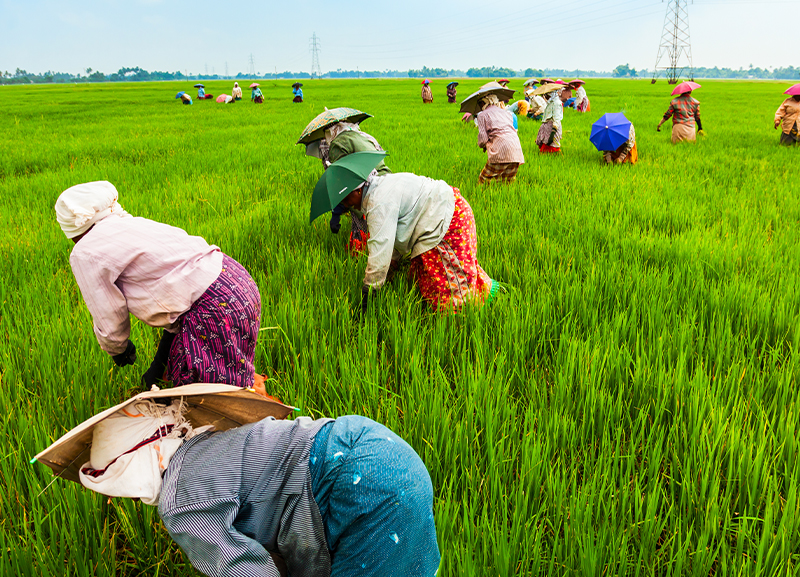
I for
Imarti
Sweets make up a large part of Indian celebrations. A few days prior to Diwali, households make many sweet and savoury dishes that are offered to guests during the five-day festival. Imarti, a sweet dish similar to jalebi, is often made during Diwali celebrations. Imartis are made with rice flour and udad dal, both of which are harvested during this season. The shape of the Imarti resembles floor chakris that are lit during the festival and open marigold flowers, that are used to decorate houses. In fact, even the colour of the imarti is similar to that of marigolds.
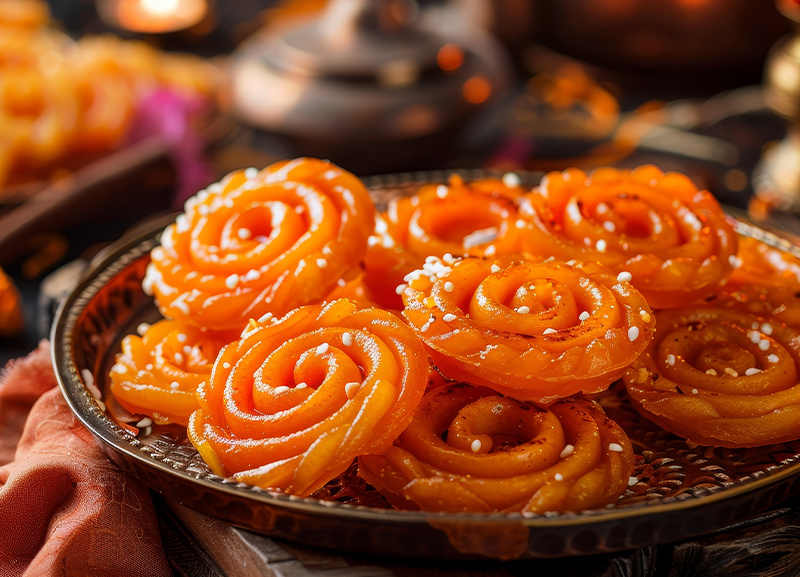
J for
Jewellery
Diwali calls for dressing up to welcome Godess Lakshmi. Women dress up in traditional clothes and wear the best of their jewellery for the annual Lakshmi Puja. Certain communities also pray to jewellery on Dhanteras day. This is because jewellery is a form of wealth and people believe that honouring wealth in this form will invite success, fame and fortune.
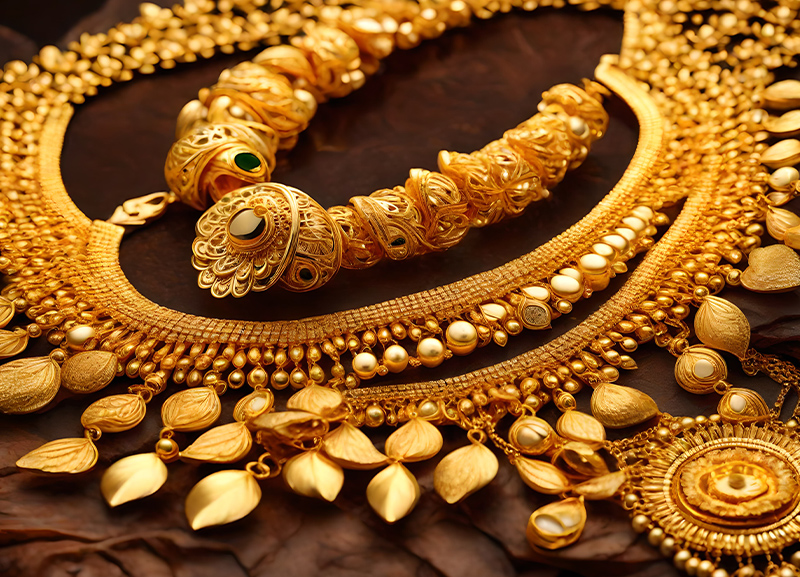
K for
Kartik
Kartik is the eighth lunar month as per the Hindu calendar and is considered to be the holiest month among all lunar months. This month holds immense importance as it is dedicated to the worship of several gods including Vishnu, Shiva, Lakshmi, Saraswati, Ganesh and Krishna. Diwali is celebrated in this month.
Kandil
Paper lanterns or kandils are an important part of Diwali celebrations. It is said that the atmosphere around a house is purified by hanging a kandil outside the main door. The concept of a kandil or akashdeep originated during Tretayuga, the second of the four epochs, according to Hinduism. Hanging an akashdeep is said to create a welcoming atmosphere. In the olden days, this was hung outside the main door on the right side (as seen from inside the house) as this side represents activated energy.
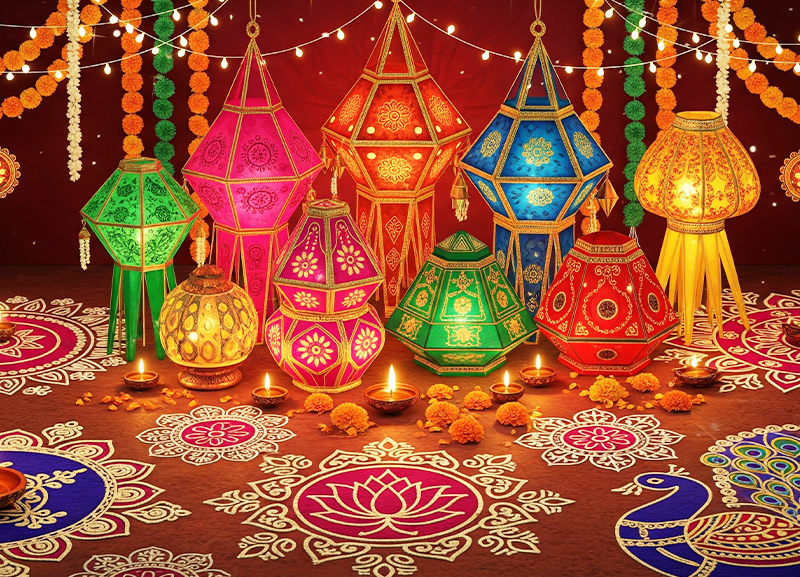
L for
Labh Panchami
Labh Panchami is celebrated on the fifth day after Diwali. On this day, a Sharda Puja is performed by those who were unable to perform the Lakshmi Puja. Members of the business community reopen their shops and business begins on this day. People pray to Goddess Lakshmi and Lord Ganesh for their business’ well-being and prosperity and also perform a puja of their new account ledgers. They do so by writing the words ‘shubh’ on the left side and ‘labh’ on the right side of the book, with the swastik in between. Devotees believe that performing a puja on this day will bring wealth, profit and good fortune on both the personal and professional front.
Lakshmi Puja
The third day of Diwali is devoted to Goddess Lakshmi and is celebrated as Lakshmi Puja. On this day, the Earth enters into the second course of its journey in relation to the position of the sun and passes through the constellation of Libra, represented by a balance or scale. Hence, this day is celebrated with a ceremony wherein businessmen balance their account books. On this day, new accounts are opened for the new year. All new account books are inked with the words ‘shubh’ meaning ‘auspicious’ and ‘labh’ meaning ‘merit’ to invoke the deity of wealth. This ceremony is called Chopda Poojan among Gujarati and Rajasthani business communities.
Lakshmi Puja consists of a combined puja for five deities. Lord Ganesh is worshipped at the beginning of every auspicious act as Vighnaharta or the remover of obstacles. Lakshmi is worshipped in her three forms—Mahalakshmi, the goddess of wealth; Mahasaraswati, the goddess of books and learning; and Mahakali. Kuber, the treasurer of the gods, is also worshipped.
Lights
Diwali is also known as the Festival of Light. While darkness is considered evil, sorrowful and ignorant, light is the symbol of divinity, knowledge and purity. A well-lit room can overshadow all bad energies and make a person feel bright and wonderful. Hence, it is important to not only light a lamp during Diwali, but also illuminate the inner soul and get rid of dark energies. The light illuminates our homes and hearts and fills them with new hope and happiness.
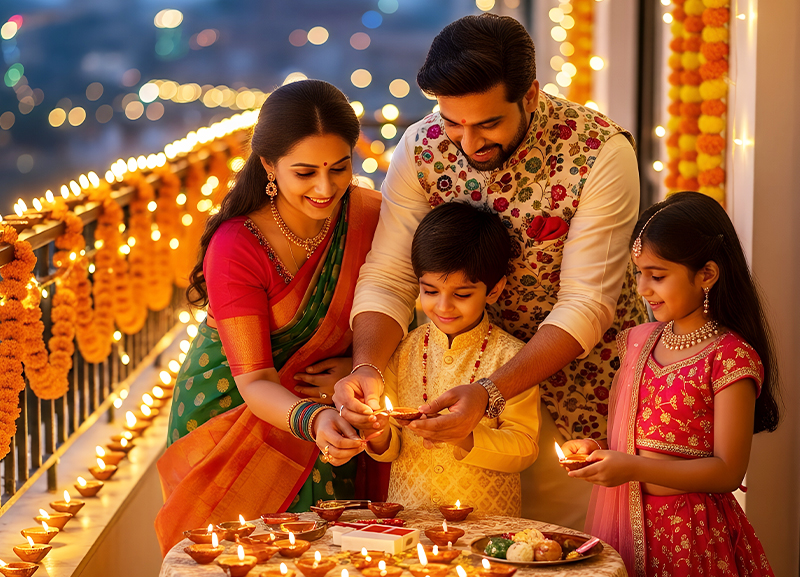
M for
Mahavir
In Jainism, Diwali was referred to as Dipalika meaning ‘splendour of lamps’. On this day, the 24th and last Jain Tirthankara, Lord Mahavir attained nirvana or moksha. Mahavir was regarded as the person who gave Jainism its present form. The word ‘moksh’ means ‘liberation of the soul’ and according to Jainism, attaining moksh is the prime objective of every soul as a liberated soul is said to have happiness, infinite knowledge and infinite perception. It is believed that Mahavir attained moksh on a new moon night. People illuminated their houses in order to symbolically keep the light of their master’s knowledge alive.

N for
Narak Chaturdashi
The second day of Diwali is known as Narak Chaudas, Narak Chaturdashi or Chhoti Diwali. This day celebrates the killing of the demon Narakasur by Lord Krishna. Large effigies of Narakasur are put up across Goa and lit after sunset to celebrate the dispelling of all evil. Bengalis believe that Goddess Kali killed the demon Raktavija on this day. In Gujarat, this day is celebrated as Kali Chaudas. People go to the temple and offer Lord Hanuman oil and fried medu wadas and pray to him to protect their family.
In Tamil Nadu, bathing water is boiled on a pyre of wooden logs that have been smeared with lime. The day begins by people taking a bath with this water before sunrise and anointing themselves with oil and uptan, a scrub made of gram flour and fragrant powders. Traditionally, 14 diyas made from flour and ghee are placed across the house on this day.
New Moon Day
The new moon day, also known as amavasya, is observed as a day of fasting in many traditional Hindu households as it is not regarded as a lucky day. This day is thus spent on forgiveness and charity in order to wash away one’s sins. However, the new moon day during Diwali is considered to be an auspicious day as it is on this day that Goddess Lakshmi visits clean homes.
New Clothes and Utensils
On Dhanteras, people purchase utensils, vehicles, clothes and gold. It is believed that newly acquired dhan (wealth) in the form of metal brings good luck as God Dhanvantri came out of the ocean during the Samudra Manthan carrying a metal pot that had the amrut or elixir of life. In Maharashtra, people lightly pound dry coriander seeds with jaggery and offer the mixture as naivedya (food) to the gods on this day.
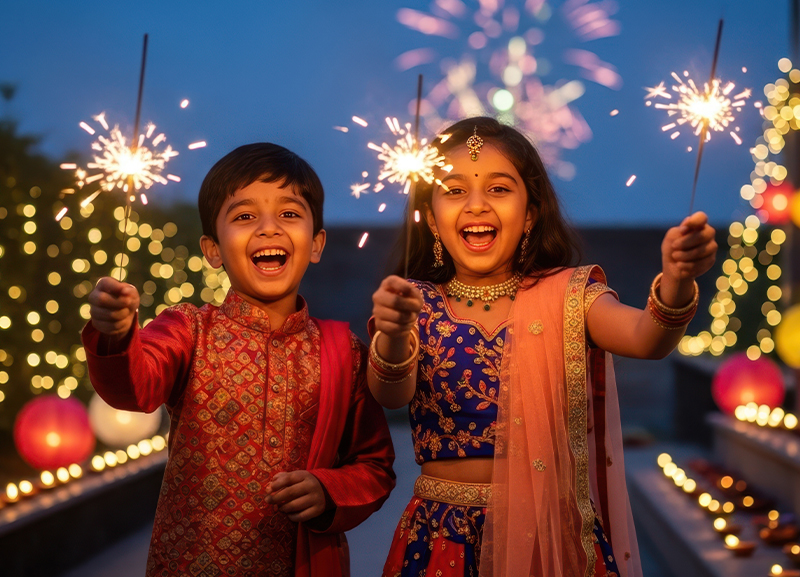
O for
Odisha
In Odisha, Diwali is celebrated with a difference. Tall bamboos with earthern pots tied to them are erected in front of households. On the inside of each pot is a lit lamp. People of Odisha believe that lighting the dark path in this manner helps the spirits of their dead ancestors find their way to heaven. Members of a household gather together just after dusk.
A rangoli of a sailboat is made on the ground. The boat has seven chambers. Over the drawing of each different chamber, several items are kept—cotton, mustard, salt, asparagus root, turmeric and a wild creeper. Over the central chamber are the offerings meant for prasad. Perched over the prasad is a jute stem with a cloth wick tied around the edge. It is lit at the beginning of the puja. All members of the family hold a bundle of jute stems in their hands. Lighting their respective bundles from the flame on the rangoli, they raise them skywards chanting.
Oil Massage
The oil massage or abhyanga snan is a ritual conducted as per the Vedas. Traditionally, it is only done during the Brahmamurat–which begins 1 hour and 36 minutes before sunrise and ends 48 minutes before sunrise–on the morning of Narak Chaturdashi. The mixture or uptan used for the bath is an ayurvedic preparation made from sandalwood, camphor, manjistha, rose, orange peels, turmeric and cream. The oil used is sesame oil. Scientifically speaking, applying oil on the skin moisturises it and cleaning the skin with the dry mix of herbs removes environmental pollutants, toxins and dead skin. The process also increases blood circulation, relieving one of stress while calming the mind.

P for
Playing Cards
Most people indulge in gambling during Diwali. According to legends, this tradition is linked to Goddess Parvati. It is believed that during Diwali, Parvati invited her husband Lord Shiva for a game of cards and he decreed that gambling on Diwali night would bring prosperity. Another legend says that both Parvati and Shiva won and lost to each other, suggesting good luck, prosperity and balance in material needs.
Pollution
Firecrackers may be fun, but they are not the best way to celebrate a festival. They actually create air, land and noise pollution. Babies and people with breathing problems, heart problems and high blood pressure are the worst affected by firecrackers.
Protecting Animals During Diwali
Diwali is also very tough on animals like dogs. Due to their superior hearing abilities, they hear sounds 40 times louder than humans do. Even birds and other small animals are affected during Diwali because they have a much stronger sense of smell and sound. The light and colour from firecrackers can also be frightening and chaotic for animals. You can help animals out by not using loud crackers and bombs. If you see injured animals, bring them to the notice of concerned authorities. If you have a pet at home, make it feel secure during these days.

Q for
Queues
If you step out on any of the five days of Diwali, you will witness queues for everything. On Dhanteras day, people queue up to buy silver coins or gold. On Lakshmi Puja day, people queue up outside stationery stores to buy accounts books and in front of flower and fruit vendors to buy the things they will need for the evening’s ceremonies. On the fourth day of Diwali, which is celebrated as Besta Varas by Gujaratis, people queue up early in the morning to buy jalebis, as it is considered auspicious to eat this sweet on the New Year day. And on the next day, which is celebrated as Bhai Dooj, people queue up to buy mithai and gifts for their siblings. People also queue up outside temples to seek blessings as they step into a New Year.
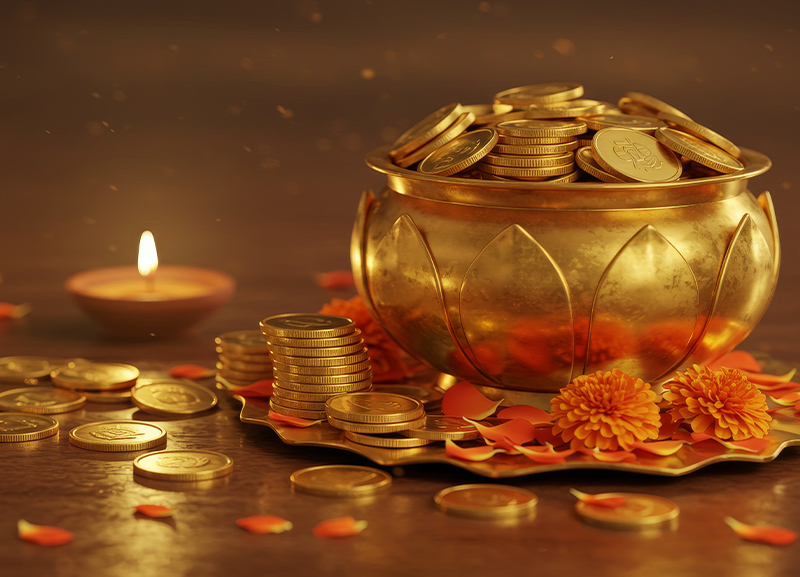
R for
Return of the Pandavs
The Mahabharat has an interesting story related to Kartik Amavasya or Diwali day. According to the story, the five Pandav brothers Yudhishthir, Bhim, Arjun, Nakul and Sahdev were sentenced to 13 years exile as a result of their defeat against Duryodhan and his 99 brothers at a game of dice. Therefore, the Pandavs spent 13 years in the jungles and returned to their kingdom on the day of Kartik Amavasya. On their return, the people of their kingdom welcomed them and celebrated the event by lighting earthen lamps all over their city.
Rangoli
The word ‘rangoli’ is derived from two words, ‘rang’, which means ‘colour’, and ‘aavalli’, which means ‘many rows’. There are numerous legends associated with the origin of rangoli, however, the best known one is related to the death of a high priest’s son. It is said that people associated with the priest were in such trauma that they prayed to Lord Brahma to bring him back to life. Moved by their prayers, Brahma asked the king to paint a portrait of the boy on the floor. He breathed life into the portrait and the boy came back to life. It is believed that this was the first rangoli created.
Another legend states that Diwali was a time when houses were freshly coated with a layer of cow dung. The process of smearing the floor left behind subtle irregular lines with irregular vibrations. These were believed to be harmful to the body, eyes and mind. To overcome these unfavourable frequencies, auspicious symbols were drawn systematically on the floor.
Traditionally, rangolis need to change through the five days of Diwali, because the change of colour, design and form changes the vibration of the house. Women would chant hymns and sacred bhajans while creating rangolis in specific patterns as these patterns were considered to be energy centres and had a positive impact on people. The design, symbols, lines and colours of a rangoli thus play an important role in the kind of energy produced. It is also believed that the entire pattern of a rangoli must be drawn as an unbroken line as a gap in the line allows evil spirits to enter the household. Others believe that the broken lines possess vibrations that are harmful to the human body.
Rangolis are also drawn to welcome Goddess Lakshmi as it is said they she only enters homes that are clean, neat and beautiful. Traditionally, rangolis were made out of rice flour or burnt rice husk and white ash. It is believed that creating rangolis out of food products provides food to the smallest of creatures, like ants and other small insects. Traditional motifs like the swastik, lotus, trident, fish and conch shell, creepers, leaves, trees, flowers and animals are seen in rangoli designs.
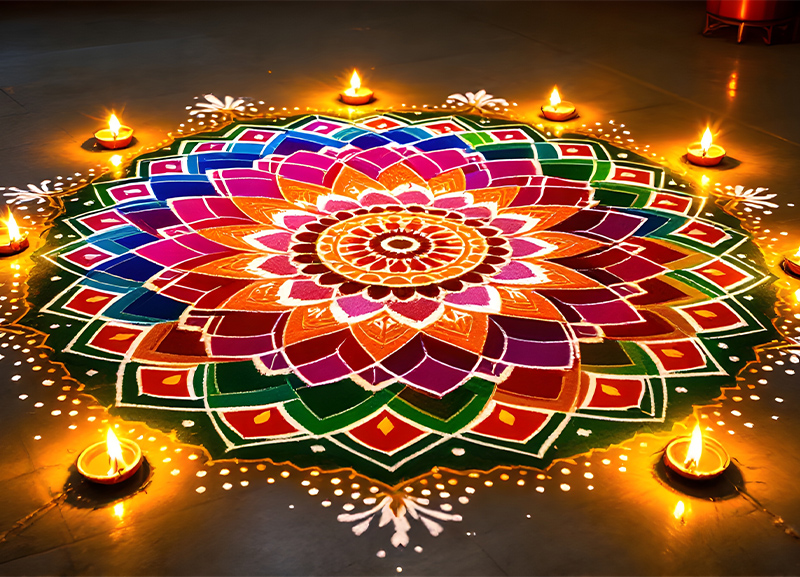
S for
Saraswati
Goddess Saraswati is regarded as the goddess of knowledge, education, wisdom, arts and culture. Hinduism believes that wealth without wisdom and knowledge is not sustainable. Thus, in order to be prosperous and wealthy, on Diwali day people pray to Goddess Lakshmi, the bestower of wealth, Lord Ganesh, the remover of all obstacles, and Saraswati, who bestows wisdom and knowledge.
Sweets and Savouries
Diwali is incomplete without special sweets and savouries that are made in every household. Interestingly, almost every family has its own recipes for traditional Diwali treats like chakli, sev, laddoo, karanji and chivda. These snacks are also referred to as ‘faral’ in Marathi and are served to the entire family as breakfast starting from the first day of Diwali. Packs of these homemade goodies are also sent to loved ones as gifts for Diwali.
In many families, specific foods are made on specific days. This has a lot to do with the fact that Diwali is a harvest festival and the foods cooked are made from the fresh produce.

T for
Thalai Deepavali
In Tamil Nadu, Diwali is celebrated by newly-weds as Thalai Deepavali or the first Diwali after a wedding. Newly-weds are showered with gifts that are given as per traditional customs. The celebrations include a visit to a temple.
Toran
During all the five days of Diwali, the main door of houses and vehicles are adorned with torans made using marigold flowers, mango leaves and fronds of the new harvest. The flowers and leaves have special significance. The marigold flower has a stout stalk, which symbolises trust in the divine. Its saffron colour symbolises surrendering to god. Its distinct fragrance is known to ward off stress and negative thoughts. The flowers are also natural insect repellents as their fragrance keeps mosquitoes and bugs away. Fresh mango leaves are said to absorb polluted air whilst circulating oxygen in the home. The colour green is calming in nature and reduces stress and anxiety. Mango leaves are also said to signify Goddess Lakshmi.
Tulsi Vivah
Tulsi Vivah is celebrated on prabhodini ekadashi or the 11th day of the Hindu month of Kartik. Tulsi, known for its medicinal properties, also symbolises spiritual purity. According to Hindu mythology, Tulsi married Lord Vishnu on this day. Thus, a tulsi vrundavan–the special structure in which the holy plant is grown–is washed, painted and decorated. Sugarcane and marigold flowers are offered to the vrundavan and tamarind and Indian gooseberries are kept at its base. The plant is decorated with a red cloth and some ornaments to make it look like a bride. A shaligram stone, to represent Vishnu, is washed and placed near the plant. The two are joined by a cotton thread to represent a marriage. It is only after this day that auspicious wedding dates are selected by Hindus.

U for
Uphar
Diwali is the season of gifting. Diwali also marks the end of the harvest season. It is the time of year when farmers are thankful for their harvest. They share their happiness by exchanging gifts, called uphar in Hindi, and sweets made from fresh crops. Traditionally, only sweets were gifted during Diwali.

V for
Vikramaditya
The day after Diwali marks the day when King Vikramaditya was coronated. The Vikram-Samvat, an era named after Vikramaditya, thus began on this day. The Hindu calendar year begins on this day.
Vishwakarma
Lord Vishwakarma is the god of architecture. He is also the creator of all the weapons of the gods. Though a Vishwakarma Puja is held during Dussehra, the day after Diwali is also celebrated in Vishwakarma’s honour. On this day, celebrations are held in factories and industrial areas. Engineers, architects, carpenters and other craftsmen pray to their tools. Soldiers pray to their weapons. People also pray to their vehicles, as Vishwakarma was responsible for creating all the modes of transport of the gods. People pray for a better future, safe working conditions and above all, success in their respective fields of work.
Vasu Baras
The day before Dhanteras is celebrated as Vasu Baras; it is a day honouring cows and calves. India is essentially an agrarian economy and a large part of its income comes through agriculture. Hence, people in many parts of rural India celebrate this day by worshipping their cows and calves, because cows are an important source of income. It is also believed that on this day, Goddess Lakshmi takes the form of a cow and people seek her blessings by praying to cows.
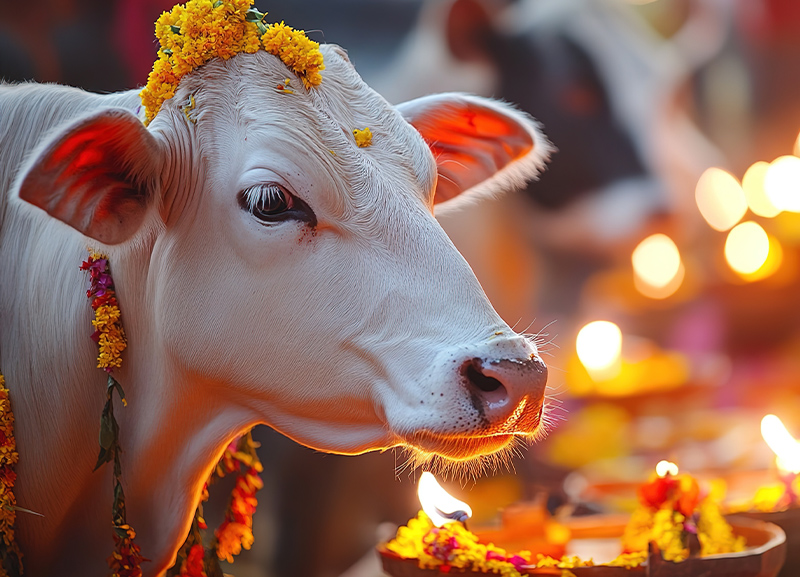
W for
Waking Up Early
Diwali officially starts during Brahmamurat, which is around 4am. Waking up early during festivals is considered to be the first step to a disciplined life. The early hours of the morning are said to be the ideal time for improving productivity, acquiring knowledge, achieving discipline and developing physical and mental health and thereby attaining success. The sages who instituted this custom hoped that their descendants would realise its benefits and make it a regular habit in their lives.
White Washing Walls
During Diwali, people clean their houses and offices to welcome positivity. It is a common belief that Goddess Lakshmi will only grace clean and nicely decorated homes. So it is important that old, useless, worn out and outdated items in the household are replaced with new items. In the olden days, after the monsoon, cow dung was smeared on the walls to repair homes. A layer of lime was then added on the walls. This white layer added brightness during the dull winter months.
Wealth and Wisdom
Goddess Lakshmi, the goddess of wealth, and Goddess Saraswati, the goddess of wisdom, are both prayed to during Diwali. Hindu scriptures teach us that both the goddesses have to be present together for a person to be prosperous. On Dhanteras and Diwali day, people pray to Lord Kuber, the treasurer of the gods. It is believed that worshipping him makes a person wealthy and prosperous. According to legends, Kuber was a devotee of Lord Shiva and he undertook penance to please Shiva. But during this time, one of his eyes got damaged due to the radiance of Goddess Parvati. Shiva was very pleased with Kuber’s devotion and blessed him with wealth and gave him the title of Ekashi Pilang.
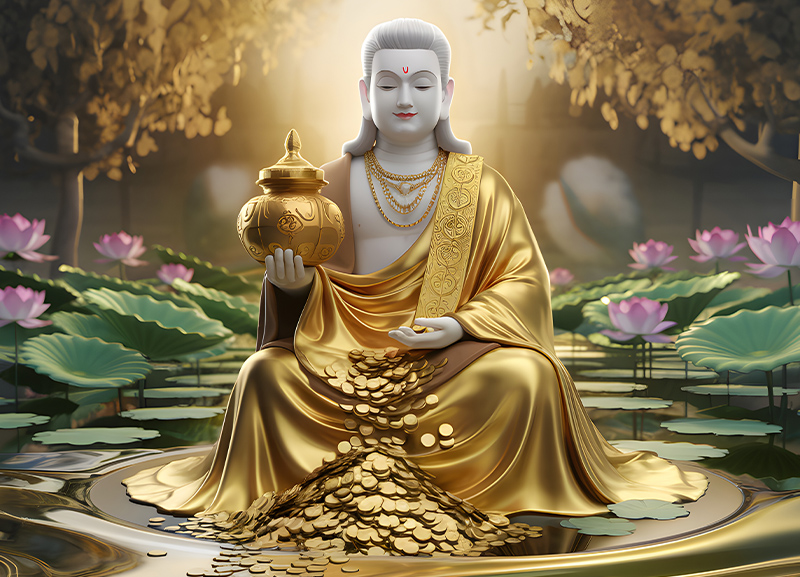
X for
Xenium
Xenium is a word of native Ancient Greek origin, which means ‘offering a gift to a stranger’. Diwali is all about charity. There’s no greater joy than helping someone less privileged than you to enjoy the festival or live a better life. One can donate clothes, food, blood or hair for those struck with cancer, sign up for organ donation and even sponsor a child’s education. There’s no limit to what you can do to help out. Do a good deed and make another person happy.
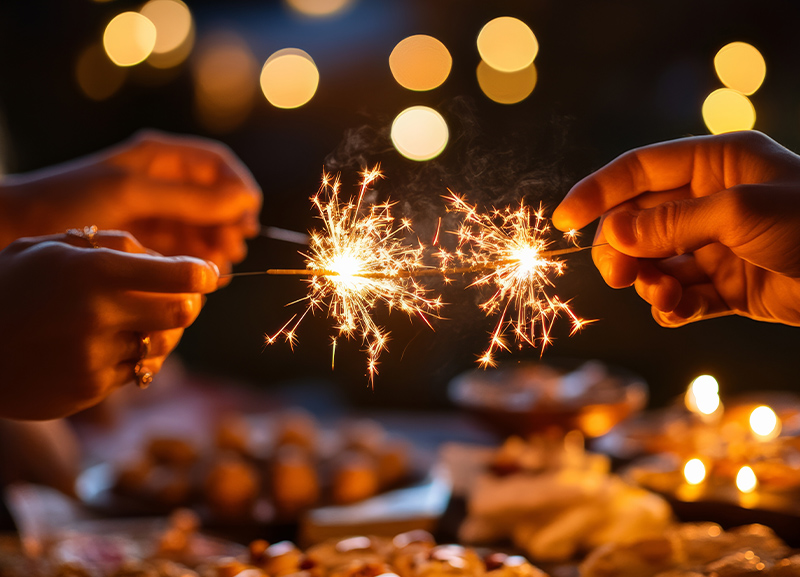
Y for
Yamadeepdaan
Yamadeepdaan is celebrated two days after Diwali day. According to legends, on this day Lord Yama, the god of death, went to visit his sister Yamuna’s house. His sister was very happy to see him and welcomed him by putting an auspicious mark on his forehead for his welfare. The siblings then shared a meal. He was so pleased with his sister’s reception that he proclaimed that every year, on this day, if a sister puts a tilak on her brother’s forehead, no harm would come to the brother. This day is also known as Bhai Dooj
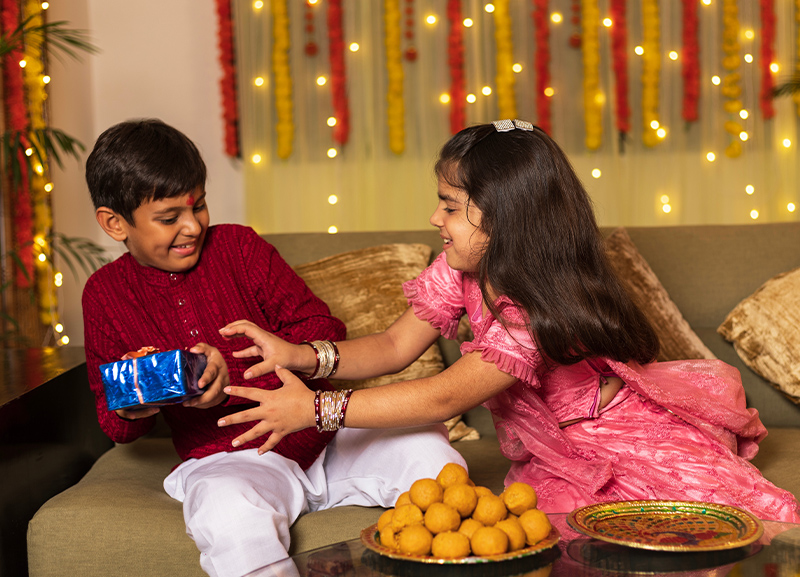
Z for
Zero-Garbage
As we get ready to celebrate Diwali, let’s pledge to do the following things to make the Earth a better place to live in:
- Say no to littering the streets with used glasses, bottles, plates, wrappers and papers from fireworks.
- Say no to bursting crackers that cause noise and air pollution.
- Say no to wasting food.
- Say yes to reduce, reuse and recycle.
- Say yes to eating right and working towards a fitter body and healthier mind.
- Say yes to starting the new year by adopting a zero-garbage policy.
